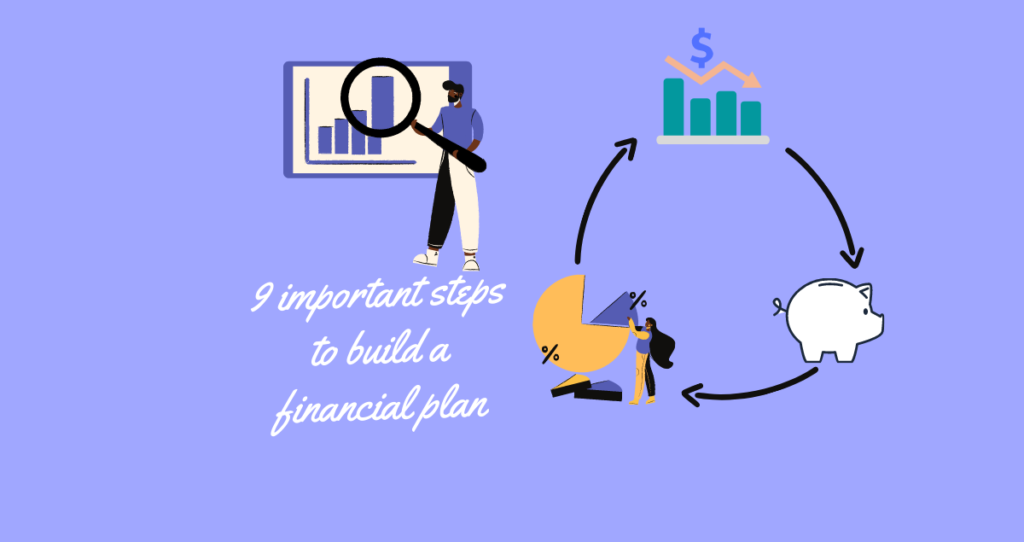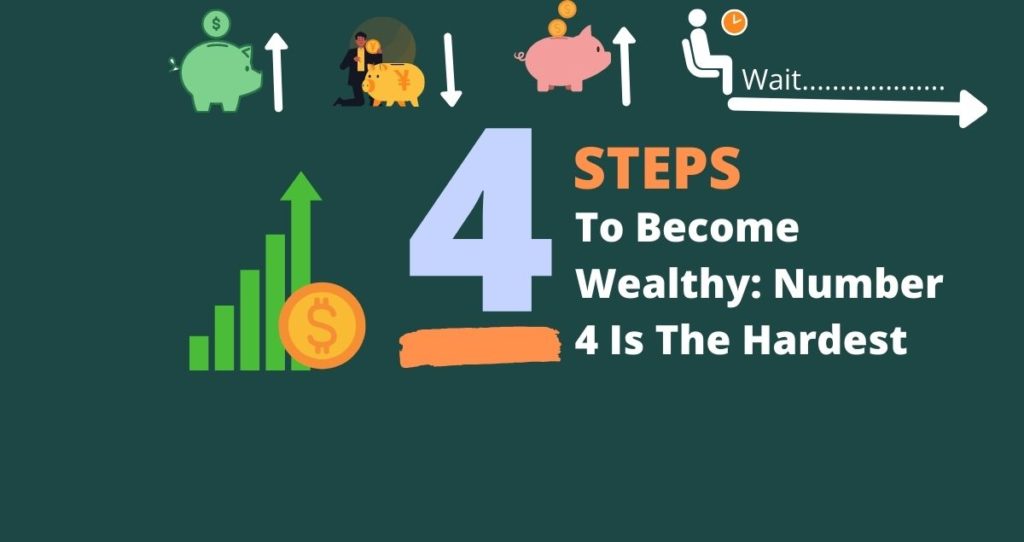Are you interested in financial planning? You should have a financial plan if you want to take control of your money and achieve financial independence. Your future lifestyle especially in retirement will depend on your financial situation. If you are broke in your retirement, for example, your final days on earth will be miserable. More importantly, you will leave nothing behind for your loved ones.
If you are interested in achieving financial greatness, you have come to the right place.
In this article, l put together a financial plan blueprint you can follow in order to achieve financial independence. This financial plan will be grouped into 9 steps you can follow.
Without further ado, let’s get started.
1. Have a financial goal

Every financial plan must have a goal. Your goal will be your greatest motivation and the reason you want to be financially independent. To fully understand this point, I want you to ask yourself the following question:
Why do I need to be financially free?
This question is very important to the success of your journey. By answering this question wrong, you will end up in the wrong destination. You must be true and honest to yourself and know exactly what you want and why you want it.
Your goal should be strong and big enough to override all obstacles you will encounter when attempting to execute your financial plan. Not everyone will see things the way you do. And not everyone will understand your goals the way you do.
For this reason, most people you tell your goals will turn you down. Some people will think you are crazy. They will abandon you, deny you support, and give you every reason you are going to fail. The only way to overcome all these setbacks and background noises is to have a goal that is bigger and strong than all these negativities.
The following are common reasons people want to be financially independent.
- Have enough money for retirement: Whether you want to retire early or want to have enough money in your retirement, this could be a great reason to hustle. None wants to be broke in their retirements and beg for food or survive on government support when they can no longer afford to work. You are working right now. But a day will come and you will never afford to go to work. How are you going to survive? Your reserve is the only thing you will rely on to support you during your final days. If you really want to have enough money in your retirement and avoid exhausting your loved ones’ resources, then go for it.
- Travel: Do you want to fly around the world and appreciate God’s creation? If so, you are not wrong about this decision. Many people dream about traveling, having fun, relocating to foreign countries, etc. However, a few individuals are able to make this dream a reality. Why do you think this is the case? My observation is that they do not believe in themselves strong enough. They think they do, but when problems come, they just give up. You don’t have to end up like them. You have got to be stronger than everyone. If you really believe that this is something you want to do while you are still alive, then make traveling your financial planning goal. Tell yourself that you want to be financially independent so that you can travel the world. Then, work hard on your goal every day and never give up until you have achieved it.
- Spending time with your loved ones: What will make you feel special during your lifetime is how much time you spent with the most important people in your life. There is no way you achieve this increadible goal when you are working two full time jobs in your retirement. So, make a financial plan that supports this goal.
- Sense of security: Money is one of the main things that worries people around the world. Mabye you don’t want to travel, spend time with loved ones, or retire early. But, being financially free will increase your sense of security. The thought that you will be able to provide for yourself and others when necessary will make you feel invincible.
There are other financial planning goals that I did not include here such as buying a house, saving for college, etc. All these goals are incredible and they differ depending on who you ask.
The question I want to ask you is:
- What are your financial goal(s)?
- Why do you want to create a financial plan in the first place?
- Can you still live your life without a financial plan?
All these questions will help you understand the true meaning of your life. This information will help you decide what matters in your life and choose the most important financial goals that satisfy it. Your goals must be bigger than yourself as you will rely on them when things are not going well.
What do you do with your financial goal(s)?
After you have figured out what your financial goals are, your next step is to write them down. Put your financial goals exactly where you will be able to see them every day to remind you what it is you are chasing. Put multiple copies where you spend most of your time. A friend of mine drafted a financial plan and put it in the living room. This is where he spends most of his time. What about you?
Some people choose to put their financial plans in the bathroom so that they can see them every morning. Regardless of where you put your financial plan, it must be visible to you and accessible whenever you want it. After writing your financial plan down and putting it where you can easily see it, you will move to the next step.
The next step is one of the most important steps in your financial planning. Read the next steps very carefully and practice as much as you can. I am not talking about rocket science. I am only talking about budgeting. Yes, budgeting is very important when it comes to managing and planning your finances. Most people don’t get it. But, you need to create a winning budget if you want to succeed.
So, let’s move to the next step.
2. Track your money through budgeting

I slightly mentioned budgeting in the previous step. It was just an introduction. In this step, we are going to dive deeper and see what budgeting is all about when it comes to making a financial plan.
You probably heard about budgeting before. Maybe you learned it in school, read it in a book, or heard it from your friends. Whatever you learned, is not that important. What is important right now is that it is not the first time you heard about budgeting and what you are going to do about it. Well, even if it is the first time, don’t worry. We will cover some basics of budgeting.
So, what is budgeting?
Budgeting is an action of allocating money to particular services or purposes in a budget. When your friends say that they are budgeting, what they mean is that they are creating a budget that helps them to track their money and spend it appropriately.
A budget is nothing other than a written estimation of your income, expenses, and leftovers. A good budget should track all your incomes, and expenses on a weekly, monthly, and yearly basis. People create budgets differently. However, I think that each budget should have the following 6 main parts.
- Income(s)
- Expenses
- The difference between income and expenses
- Target expenses (this allows you to cut down on your expenses)
- Actual expenses
- Difference between target expenses and actual expenses
In this section, we will only focus on the first, second, and third sections. The last three sections will come into play when you are trying to cut down expenses and increase your savings. That is you will set a maximum amount you want to spend on each item and compare that with the actual expense at the end of the month.
For example, let’s say that you want to spend at most $50 on phone-related expenses every month. At the end of the month, you realized that you spent $45. The difference between your target and actual expenses is $5. In other words, you beat your spending goal by $5. The difference between your target expenses and actual expenses shows you if you are going over budget or respecting the budget.
Part 1: Income(s)
Your income is consists of every penny you make. Most people have just one income which comes from their full-time jobs. However, there are other forms of income that should not be ignored.
The following are examples of incomes that some people have that come from:
- Investments
- Gifts
- Allowances
- Wages
- Salaries
- Commission
- Interest
- Income from selling products
- Royalties
It is possible that you don’t have all these incomes and that is OK. We will use the income you have. If you have multiple incomes, you will need to list your incomes on your budget and add all of them together. For example, if your net income from your job is $20,000 and your total income from investments is $10,000, your total net income will be $30,000.
Most people use their gross incomes in their budget which is one of many budgeting mistakes to avoid. I recommend a different approach when putting together a budget. Instead of using your gross income, use your total net income.
When you make a budget using gross income, you are technically using the money that is not yours. That is you are using tax money which must go to the government. Including tax money in your budget will negatively impact the accuracy and practicality of your budget.
Part 2: Expenses
The second part of budgeting is to compile all your expenses. When it comes to expenses, you should add up everything you spend money on. Most people consider expenses such as rent, insurance, car payments, and food, and forget everything else.
Your expenses run much deeper than this. What about your phone services, Netflix subscriptions, gym memberships, dining out, medications, etc. All these and many more are part of your expenses.
To make it easy for you, everything that costs you money is an expense. The following is a list of expenses that most people have. Yours could be more or less depending on your lifestyle.
- Mortgage payments
- Rent
- Food expenses (groceries shopping, dining out, food give aways, etc)
- Car expenses (gas, insurance, maintenance, loan payments, interest, etc)
- Phones expenses (data, minutes, movies and app subscriptions)
- Shoppings (clothes, shoes, and related items)
- Entertainment (movies subscriptions, streaming services, apps, newspaper subscriptions, video games, etc.)
- Internet/TV
- Kids toys and related expenses
- Miscellanous
You are probably not going to have all these expenses. For example, if you have a rent payment, it is unlikely that you will have a mortgage payment at the same time. You can have both if, for example, you are a landlord and own multiple properties. Also, if you are single and have no children, you will not have kids’ expenses. It is also possible that you have more expenses than what I listed above.
What you are going to do now is to write down everything that costs you money. Write them down in budgeting software such as MS Excel in one column.
A good way to track these expenses is to write them down and how much they cost one by one. In addition, make sure you include how often you make those payments. After you have calculated how much you spend on each expense, you will then sum them up and calculate the total monthly expense.
Part 3: The difference between incomes and expenses
Part 1 and part 2 showed you how much you make and how much you spend on a monthly basis. Now I want you to go ahead and calculate the difference between the two numbers. That is you subtract your total expense from your total net income.
What did you find? You should come to one of the following conclusions.
(1) The difference between your income and expense is positive. This answer means that you are making money more than your expenses. In other words, you are saving some money every month.
(2) The difference is $0. If the difference between your income and expense is $0, it means that you are not saving anything at all. If unforeseen expenses such as an emergency come along, you are going to have a rough time coping with them. You have no money to cover this extra expense, and therefore, you are in trouble. You should pray that nothing bad happens to you.
(2) The difference between your income and expenses is negative. If this is the case, you are spending more money than you make. In other words, you are in deep trouble and need some assistance and immediate action. You need to make hard financial decisions and turn your life around now.
Regardless of whether you are saving money or not, you are still going to move forward from here. Financial decisions you have made in the past no longer matter. What matters is what you are going to do from here.
In terms of creating a workable budget, you are not done yet. You just created a snapshot of how you make money, how it is spent, and how much you save every month.
Even if you are not saving anything at all, don’t panic. We are now going to move forward to the next phase of creating a financial plan which is increasing your savings.
3. Increase your savings

Did you get surprised by how much you are making compared to what you are saving? I can’t blame you. The first time I created a budget, I thought I was working only to give my money away. To be honest with you, I was not saving anything at all.
I started turning my life around after making a financial plan that allowed me to save more money. That is why I have decided to put together this financial plan to help you turn your life around as well.
In this section, we are going to figure out how to increase your savings.
There are many ways to increase your savings. The easiest and smartest way to increase savings is by reducing your expenses.
This point brings us back to the budget you just started creating. At this point, you only have what you make and where it is spent. The next phase is to reduce how much you spend.
That is for every expense, we are going to see how you can reduce how much you spend on it. For example, if you spend $500 per month on groceries, you can reduce it to $300. In this case, you will be saving $200 on groceries every month (assuming that you are able to spend only $300 on groceries).
In this example,
- Target expense = $300 (4th part in your budget)
- Actual expense = $300 (5th part in your budget)
- Difference = $300-$300 = $0 (6th in your budget)
That $0 means that you have met your goals. The key point here is that you used to spend $500 on groceries but now you are spending only $300. This translates to $200 being saved every month.
Apply this technique to all of your expenses and maximize your savings.
Keep in mind that there are some expenses that cannot be reduced right away. For example, you cannot just cut down your rent before the end of your lease term. If you are spending a lot of money on rent, consider moving into a much cheaper apartment/house at the end of the lease instead of renewing the same lease.
Saving Tip: Increase your savings by eliminating your wants.
Just because you have listed all your expenses, it does not mean you need all of them. There are some expenses that are there because you feel like you want them. The truth is you will lose nothing if these expenses are eliminated. For example, if you have Netflix, Hulu, Disney, HBO, and Amazon Prime, you can keep only one of them and cancel the others. These expenses are not needed and you will lose nothing if they are gone.
Look into your list of expenses and eliminate everything that is a want. Once these are gone, you will then move to manage how much you spend on needs. That is right. You don’t need to pay a premium price on what you eat, wear, or drink. Buy what you need and manage how much you spend on them.
To make sure that you track everything, you are going to add another column in your budget on every expense. This column will include your target expense. For example, if you currently spend $200 on entertainment, make your max expense $100. That is you are trying to cut your entertainment bill in half or 50%. Do this for every expense you have.
At the end of each month, go ahead and calculate the difference. Did you beat your price target or did you go over?
If you spent less than your price target, you are doing a great job. If not, keep trying.
These saving habits will help you stay on your budget and increase your savings.
The following article will guide you through ways you can reduce your expenses and save more money.
- 16 ways to save money on utility bills
- 20 tips to save money on car insurance
- 45 Ways to save money on groceries
- How to save money on gas? 9 Tips to use
- How to lower property tax? Save money in tax
- 33 ways to save money while traveling
- Frugal Living: 19 tips that will save you money
- How to save money: Step By Step
- Save money: 44 things you must stop buying to save money
4. Create an emergency fund

You have created a budget and increased your savings. So, what are you going to do with the money you are saving? Some people choose to put their savings under the mattress or in a jar. Others put their savings in a checking account or savings account.
So, what is the right way to use the money you are saving?
The first thing that comes to mind should be creating an emergency fund. If you did not know already, an emergency fund is one of the greatest accounts you should have no matter your income, age, or where you live.
An emergency fund is nothing other than the money you put aside to help you cope with unforeseen expenses.
What would you do if you get laid off for six months and have nothing saved? Remember, you just lost your job but all your expenses are still there. You still have rent to pay or mortgage payment. You will still need food, drink, use your phone, etc. How are you going to survive?
This is why you need an emergency fund. You need to have money that is accessible any time to save you when things are not looking right.
Your emergency fund should have at least 3 to 6 months of your expenses saved. The closer you get to six months or more the better.
What you are going to do at this stage is to build an emergency fund as fast as you can. The money you are saving through budgeting should be used to build an emergency fund. After you have built your emergency fund, the same money can be used for something else.
The purpose of a financial plan is to help you stay out of financial troubles for as long as possible and hopefully become financially independent. So, an emergency fund will keep you out of trouble.
Before moving forward, make sure that you have built a very solid emergency fund.
Related: 4 ways to save for an emergency fund fast
5. Pay off your debt
We cannot move forward without talking about your debt. Millions of people are in debt and it is becoming almost impossible to make meaningful financial progress for them. Getting rid of your debt is a powerful step you must take to gain control of your finances.
Not only that you will live a miserable life due to debt, but also, the people you leave behind will inherit your debt. Nothing good comes out of debt unless you are investing.
You are probably saying: Debt is good because I was able to buy my brand new car using car loans. My question to you is: Who is benefiting from the debt you took out? Is it you or the dealership and the bank that gave you the money?
If you have debt already, it is time to start paying it off instead of accumulating more.
Without getting rid of your debt, it will be difficult to achieve financial independence. The moment you owe no money, that is when you will start reaping the benefits of a financial plan and the freedom that comes with it.
Assuming that you have debt already, how are you going to pay it off.
My recommendation is to pay off your debt starting with the most expensive debt first. That is right. You are probably saying: How do I know what the most expensive debt is? Before I answer this question, we will start by looking into common debts most people have.
Common debts
- Mortgages
- Student loans
- Personal loans
- Car loans
- Credit cards debt
These are common debts that are holding most people down. According to debt.org, the US consumer debt is $14.6T and it is shared among 340 million people. To summarize this statistic, you can safely say that almost every American has debt. If you don’t have credit card debts, you have a car loan. Those without car loans, student loans, or mortgages, have other forms of loans.
Debt will hold you back and make it difficult for you to afford anything else unless you borrow more. That is why you should pay off your debt as fast as possible. You should also start with expensive debt first.
What is an expensive debt?
I define an expensive debt as a debt that will grow over time if you do not take action fast or one that costs you a ton of money in interest compared to others. For example, even if you have a $300,000 mortgage, your $30,000 in credit card debts could be more expensive than this mortgage.
This is because credit cards have the highest interest rate known as the annual percentage rate (APR) in the lending industry. More importantly, this debt is compounded which makes it grow exponentially over time. Your mortgage, on the other hand, does not grow over time. It goes down as you pay it off every month.
Make a serious plan that will help you pay off your debt faster. Get a second job if you must. Paying off your debt is a very crucial step you must take in your financial planning. Why would you worry about investing money if the interest charges on your debts eat up all even more of return on investment (ROI)? Know your priorities and make educated financial decisions.
The following articles can guide you through paying off some of your debts.
- Why is it a bad idea to pay off the smallest debt first?
- How to pay off student loans: 16 easy tips to use
- How to pay off debt? 11 Tips you can use
- How to pay off credit card debt? 10 tips I used
- Struggling with debt? This is why people struggle with debt
- 11 easy ways to reduce credit card debt
6. Start your retirment accounts

At this point, you have put a plan in place that will help you save money, manage your expenses, save for emergency funds, and pay off debt. Your next step is to work on your retirement. No matter how much you have or need for retirement, you will still plan for it.
Why retirement?
Think about this scenario. You are super strong and feel invincible. You feel like you will never age, lose your physical and mental abilities. The hard truth is that everything will change one day. Your health will deteriorate, you will no longer be able to move without assistance. At the end of the day, you will no longer be able to work.
Where is the catch? Your expenses will still be there. Your living, food, medical expenses, etc, will all be there. You will not have extra active income, but all of your expenses and many more will be there.
How do you think you will finance these expenses? I don’t think you are planning to live on the streets, eat nothing, drink nothing, and avoid hospital when you are sick. The only way to survive is to have enough money saved for your retirement.
Everything you are doing right now, countless hours you are working, and decisions you are making, all come to one simple element: Retirement. Most people never think about retirement until it is too late. The good news is that you don’t have to be like everyone else. You don’t have to leave your precious future life to chance.
Your financial plan should include your retirement plan.
What is a retirement plan?
A retirement plan is nothing other than an estimate of how much money you will need in your retirement, the time horizon, and how your money will be spent. The plan should also include risk assessments as you will not be working during your retirement.
Before you retire, there is an amount of money you will have. This money will include your assets, income-generating investments, and retirements accounts. Every dollar you have will be added together to determine how much money you will have in total.
From there you should estimate a timeline at which you are planning to live. This will help you come up with a monthly expense you must stay under to not run out of money.
Tip: Figure out how much you will need in your retirement based on your monthly expenses and try to save that money or higher before you retire.
A good retirement plan is one that will let you have assets that generate an income that is higher than your monthly expenses. With this plan, you will never run out of money.
What are retirement accounts to start with?
The basic and most important retirement accounts to start with are your 401k and IRA. A 401k is an account provided by your employer where you put in pretax money from every paycheck. Your employer also matches your contribution at a certain percentage or contributes a particular dollar amount. This way, your money grows faster.
Those without access to 401k accounts should open IRA accounts. You can also have a 401K and IRA at the same time. These accounts have advantages to taxes and they can help you reach your retirement target amount faster. As always it is a good idea to invest your money and pay tax later. This is a clever way to reach your financial independence faster without hustle.
Your retirement account is not a savings account. For this reason, you must invest the money in your retirement accounts in investment options inside your brokerage account.
7. Save to invest

In the previous sections, we discussed saving options and retirement accounts. The money you save or put in your retirement accounts should be invested to maximize your returns. That is you should always put your money to work instead of keeping it in your accounts.
Investing your money will help in two ways.
(1) Protection against inflation: Inflation is the rate at which a currency loses its value due to the increase in the prices of goods and services. This is a simple definition of inflation. In other words, inflation will reduce the value of your money over time. For example, according to The People History, the cost of an average new car was $2,752, in 1960. The same amount of money would not buy you a car in today’s economy.
The point here is that the progressive increase of goods and services reduced the value of money. Investing your money in investments that yield higher than the inflation rate will protect your money from losing its value.
(2) Investments help you reach financial independence faster: The money invested will give you a return. This return is what will help you grow your portfolio. For example, if you have bought dividend-paying stocks and chose to reinvest your dividends, your portfolio will grow faster. This is because you will be earning dividends on the principal amount and dividends you reinvested.
A successful financial plan should have a solid investment plan that focuses on maximizing your returns but also protects you from major losses. As always the best investment is the one that ensures the protection of the principal and gives you a return at the same time.
The world of investing can be intimidating. If you are not sure about proper ways to invest money, work with an investment advisor. An advisor will guide you proper guidance you need, help you build a portfolio that fits your needs, and keep your mind at ease when things are not looking well.
The following articles will help you get started with investing.
- Where to invest money: An Investment guide
- How to invest money: An investment guide
- How much money should I invest?
- 6 Financial mistakes to avoid at all cost
- How to increase your net worth
- Day trading for beginners
8. Make decisions on your Will and wealth transfer

A financial plan is not complete without plans to who will take over after you are gone. I am sorry to put it this way, but you will not live forever. One day you will depart and go to your creator. The bad news is that you will leave behind all wealth and possessions you have accumulated.
What do you think will happen to your wealth after you are gone? This is where the will and wealth transfer will come in.
You will need to decide who will take over your wealth ahead of time.
In your will, you must specify how your wealth and all assets will be distributed. You should make it clear to who gets what and what percentages. All your assets should be allocated to people based on the way you want them. Without a will, your loved ones could have trouble sharing what you left behind.
On top of family conflicts, some of your money could end in government possessions or be liquidated to properly distribute it to everyone who claims rights on it.
9. Track your progress
The last step in your financial plan is to track your progress. Just because you decided to invest in an aggressive portfolio, it does not mean you will continue to keep it the same 30 years later. There are times when you will want to make some adjustments to your portfolio to meet your future projections.
Young people tend to choose aggressive investments and change them to less aggressive as they grow old. This is because it is easy to take risks when you are young. As you approach your retirement, choices you make should be carefully selected, and make choices that minimize risks.
You should constantly evaluate how well you are doing and make sure that you are on the right track.









